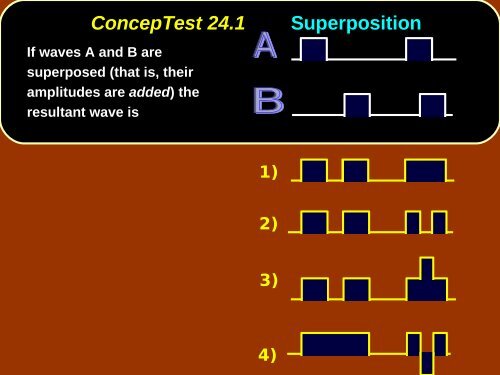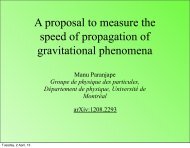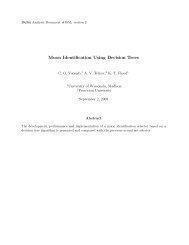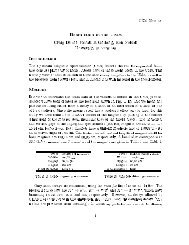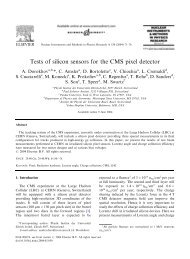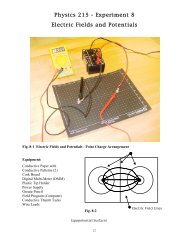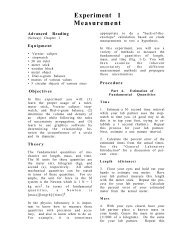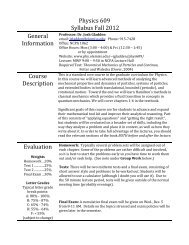Chap. 24 Conceptual Modules Giancoli
Chap. 24 Conceptual Modules Giancoli
Chap. 24 Conceptual Modules Giancoli
Create successful ePaper yourself
Turn your PDF publications into a flip-book with our unique Google optimized e-Paper software.
ConcepTest <strong>24</strong>.1<br />
Superposition<br />
If waves A and B are<br />
superposed (that is, their<br />
amplitudes are added) the<br />
resultant wave is<br />
1)<br />
2)<br />
3)<br />
4)
ConcepTest <strong>24</strong>.1<br />
Superposition<br />
If waves A and B are<br />
superposed (that is, their<br />
amplitudes are added) the<br />
resultant wave is<br />
1)<br />
The amplitudes of<br />
waves A and B have to<br />
be added at each<br />
point!<br />
2)<br />
3)<br />
4)
ConcepTest <strong>24</strong>.2a<br />
The two waves shown are<br />
Phase Difference I<br />
1) out of phase by 180 o<br />
2) out of phase by 90 o<br />
3) out of phase by 45 o<br />
4) out of phase by 360 o<br />
5) in phase
ConcepTest <strong>24</strong>.2a<br />
The two waves shown are<br />
Phase Difference I<br />
1/4λ<br />
1) out of phase by 180 o<br />
2) out of phase by 90 o<br />
3) out of phase by 45 o<br />
4) out of phase by 360 o<br />
5) in phase<br />
The two waves are out of phase by<br />
1/4 wavelength (as seen in the<br />
figure) , which corresponds to a<br />
phase difference of 90 o .<br />
Follow-up: What would the waves look like for no. 4 to be correct?
ConcepTest <strong>24</strong>.2b<br />
Two light sources emit waves of<br />
λ = 1 m which are in phase. The two<br />
waves from these sources meet at a<br />
distant point. Wave 1 traveled 2 m<br />
to reach the point, and wave 2<br />
traveled 3 m. When the waves meet,<br />
they are<br />
Phase Difference II<br />
1) out of phase by 180 o<br />
2) out of phase, but not by<br />
180 o<br />
3) in phase
ConcepTest <strong>24</strong>.2b<br />
Two light sources emit waves of<br />
λ = 1 m which are in phase. The two<br />
waves from these sources meet at a<br />
distant point. Wave 1 traveled 2 m<br />
to reach the point, and wave 2<br />
traveled 3 m. When the waves meet,<br />
they are<br />
Phase Difference II<br />
1) out of phase by 180 o<br />
2) out of phase, but not by<br />
180 o<br />
3) in phase<br />
Since λ = 1 m, wave 1 has traveled twice this<br />
wavelength while wave 2 has traveled three<br />
times this wavelength. Thus, their phase<br />
difference is one full wavelength, which means<br />
they are still in phase.
ConcepTest <strong>24</strong>.3a<br />
In a double-slit experiment,<br />
when the wavelength of the light<br />
is increased, the interference<br />
pattern<br />
Double Slits I<br />
1) spreads out<br />
2) stays the same<br />
3) shrinks together<br />
4) disappears
ConcepTest <strong>24</strong>.3a<br />
In a double-slit experiment,<br />
when the wavelength of the light<br />
is increased, the interference<br />
pattern<br />
Double Slits I<br />
1) spreads out<br />
2) stays the same<br />
3) shrinks together<br />
4) disappears<br />
d sin θ<br />
λ<br />
If λ is increased and d does<br />
not change, then θ must<br />
increase, so the pattern<br />
spreads out.<br />
= m
ConcepTest <strong>24</strong>.3b Double Slits II<br />
If instead the slits are moved<br />
farther apart (without changing<br />
the wavelength) the interference<br />
pattern<br />
1) spreads out<br />
2) stays the same<br />
3) shrinks together<br />
4) disappears
ConcepTest <strong>24</strong>.3b Double Slits II<br />
If instead the slits are moved<br />
farther apart (without changing<br />
the wavelength) the interference<br />
pattern<br />
1) spreads out<br />
2) stays the same<br />
3) shrinks together<br />
4) disappears<br />
d sin θ<br />
λ<br />
= m<br />
If instead d is increased and<br />
λ does not change, then θ<br />
must decrease, so the<br />
pattern shrinks together<br />
Follow-up: When would the interference pattern disappear?
In a double-slit experiment, what<br />
path difference have the waves<br />
from each slit traveled to give a<br />
minimum at the indicated<br />
position?<br />
ConcepTest <strong>24</strong>.4<br />
Path Difference<br />
1) there is no difference<br />
2) half a wavelength<br />
3) one wavelength<br />
4) three wavelengths<br />
5) more than three wavelengths<br />
Intensity
In a double-slit experiment, what<br />
path difference have the waves<br />
from each slit traveled to give a<br />
minimum at the indicated<br />
position?<br />
ConcepTest <strong>24</strong>.4<br />
Path Difference<br />
1) there is no difference<br />
2) half a wavelength<br />
3) one wavelength<br />
4) three wavelengths<br />
5) more than three wavelengths<br />
For Destructive Interference<br />
Intensity<br />
δ = 1/2 λ, 3/2 λ, 5/2 λ, 7/2 λ, …<br />
λ<br />
2λ<br />
3λ<br />
= (m + 1/2) λ<br />
λ/2<br />
3λ/<br />
2 5λ/2<br />
7λ/2
An interference pattern is seen from<br />
two slits. Now cover one slit with<br />
glass, , introducing a phase<br />
difference of 180° ° (1/2 wavelength)<br />
at the slits. How is the pattern<br />
altered?<br />
ConcepTest <strong>24</strong>.5<br />
Interference Pattern<br />
1) pattern vanishes<br />
2) pattern expands<br />
3) bright and dark spots<br />
are interchanged<br />
4) pattern shrinks<br />
5) no change at all<br />
Double slit<br />
Interference pattern<br />
wave
ConcepTest <strong>24</strong>.5<br />
Interference Pattern<br />
An interference pattern is seen from<br />
two slits. Now cover one slit with<br />
glass, , introducing a phase<br />
difference of 180° ° (1/2 wavelength)<br />
at the slits. How is the pattern<br />
altered?<br />
1) pattern vanishes<br />
2) pattern expands<br />
3) bright and dark spots<br />
are interchanged<br />
4) pattern shrinks<br />
5) no change at all<br />
If the waves originating from the<br />
two slits have a phase difference<br />
of 180° when they start off, the<br />
central spot will now be dark !!<br />
To the left and the right, there will<br />
be bright spots. Thus, bright and<br />
dark spots are interchanged.<br />
Double slit<br />
wave<br />
Interference pattern<br />
Follow-up: What happens when the phase difference is 90°?
ConcepTest <strong>24</strong>.5a<br />
The diffraction pattern below arises<br />
from a single slit. If we would like<br />
to sharpen the pattern, i.e., make<br />
the central bright spot narrower,<br />
what should we do to the slit width?<br />
Diffraction I<br />
1) narrow the slit<br />
2) widen the slit<br />
3) enlarge the screen<br />
4) close off the slit
ConcepTest <strong>24</strong>.5a<br />
The diffraction pattern below arises<br />
from a single slit. If we would like<br />
to sharpen the pattern, i.e., make<br />
the central bright spot narrower,<br />
what should we do to the slit width?<br />
Diffraction I<br />
1) narrow the slit<br />
2) widen the slit<br />
3) enlarge the screen<br />
4) close off the slit<br />
The angle at which one finds the first<br />
minimum is:<br />
sin θ<br />
= λ / d<br />
The central bright spot can be<br />
narrowed by having a smaller<br />
angle. This in turn is accomplished<br />
by widening the slit.<br />
d<br />
θ<br />
θ
ConcepTest <strong>24</strong>.5b<br />
Diffraction II<br />
Blue light of wavelength λ passes<br />
through a single slit of width d and<br />
forms a diffraction pattern on a screen.<br />
If the blue light is replaced by red light<br />
of wavelength 2λ, the original<br />
diffraction pattern can be reproduced if<br />
the slit width is changed to:<br />
1) d/4<br />
2) d/2<br />
3) no change needed<br />
4) 2 d<br />
5) 4 d
ConcepTest <strong>24</strong>.5b<br />
Diffraction II<br />
Blue light of wavelength λ passes<br />
through a single slit of width d and<br />
forms a diffraction pattern on a screen.<br />
If the blue light is replaced by red light<br />
of wavelength 2λ, the original<br />
diffraction pattern can be reproduced if<br />
the slit width is changed to:<br />
1) d/4<br />
2) d/2<br />
3) no change needed<br />
4) 2 d<br />
5) 4 d<br />
d sinθ = mλ (minima)<br />
If λ → 2λ then we must have d →<br />
2d for sin θ to remain unchanged<br />
(and thus give the same diffraction<br />
pattern).<br />
d<br />
θ<br />
θ
ConcepTest <strong>24</strong>.6<br />
Imagine holding a circular disk<br />
in a beam of monochromatic<br />
light. If diffraction occurs at<br />
the edge of the disk, the center<br />
of the shadow is<br />
Diffraction Disk<br />
1) darker than the rest of the shadow<br />
2) a bright spot<br />
3) bright or dark, depends on the<br />
wavelength<br />
4) bright or dark, depends on the<br />
distance to the screen
ConcepTest <strong>24</strong>.6<br />
Imagine holding a circular disk<br />
in a beam of monochromatic<br />
light. If diffraction occurs at<br />
the edge of the disk, the center<br />
of the shadow is<br />
Diffraction Disk<br />
1) darker than the rest of the shadow<br />
2) a bright spot<br />
3) bright or dark, depends on the<br />
wavelength<br />
4) bright or dark, depends on the<br />
distance to the screen<br />
By symmetry, all of the waves<br />
coming from the edge of the disk<br />
interfere constructively in the<br />
middle because they are all in<br />
phase and they all travel the same<br />
distance to the screen.<br />
Follow-up: What if the disk is oval and not circular?
ConcepTest <strong>24</strong>.7a<br />
Parallel Slides I<br />
Consider two identical microscope<br />
slides in air illuminated with light from<br />
a laser. The slides are exactly parallel,<br />
and the top slide is moving slowly<br />
upward. What do you see when<br />
looking from the top view?<br />
1) All black<br />
2) All white<br />
3) Fringes moving apart<br />
4) Alternately all black, then<br />
all bright
ConcepTest <strong>24</strong>.7a<br />
Parallel Slides I<br />
Consider two identical microscope<br />
slides in air illuminated with light from<br />
a laser. The slides are exactly parallel,<br />
and the top slide is moving slowly<br />
upward. What do you see when<br />
looking from the top view?<br />
1) All black<br />
2) All white<br />
3) Fringes moving apart<br />
4) Alternately all black, then<br />
all bright<br />
As the distance between the two slides<br />
decreases, the path difference between<br />
the interfering rays changes. Thus, the<br />
phase between the interfering rays keeps<br />
changing, alternately in phase<br />
(constructive) and out of phase<br />
(destructive) as the top slide moves.
ConcepTest <strong>24</strong>.7b<br />
A laser shines on a pair of identical<br />
glass microscope slides that form<br />
a very narrow edge. The waves<br />
reflected from the top and the<br />
bottom slide interfere. What is the<br />
interference pattern from top view?<br />
Parallel Slides II<br />
1)<br />
2)<br />
edge
ConcepTest <strong>24</strong>.7b<br />
A laser shines on a pair of identical<br />
glass microscope slides that form<br />
a very narrow edge. The waves<br />
reflected from the top and the<br />
bottom slide interfere. What is the<br />
interference pattern from top view?<br />
Parallel Slides II<br />
1)<br />
2)<br />
edge<br />
Right at the edge, the two<br />
reflected rays have no path<br />
length difference and therefore<br />
should interfere constructively.<br />
However, the light ray reflected<br />
at the lower surface (point E)<br />
changes phase by λ/2 because<br />
the index of refraction of glass<br />
is larger than that of air.
ConcepTest <strong>24</strong>.7c<br />
Consider two identical microscopic<br />
slides in air illuminated with light<br />
from a laser. The bottom slide is<br />
rotated upwards so that the wedge<br />
angle gets a bit smaller. What<br />
happens to the interference<br />
fringes?<br />
Parallel Slides III<br />
1) Spaced farther apart<br />
2) Spaced closer together<br />
3) No change<br />
ray 2<br />
ray 1<br />
ray 3<br />
t
ConcepTest <strong>24</strong>.7c<br />
Consider two identical microscopic<br />
slides in air illuminated with light<br />
from a laser. The bottom slide is<br />
rotated upwards so that the wedge<br />
angle gets a bit smaller. What<br />
happens to the interference<br />
fringes?<br />
Parallel Slides III<br />
1) Spaced farther apart<br />
2) Spaced closer together<br />
3) No change<br />
The path difference between ray #2 and<br />
ray #3 is 2t (in addition, ray #3<br />
experiences a phase change of 180°).<br />
Thus, the dark fringes will occur for:<br />
2t = m mλ<br />
m = 0,1,2,…<br />
ray 1<br />
ray 2<br />
ray 3<br />
If t gets smaller, ray #2 and ray #3 have to<br />
be farther apart before they can<br />
interfere, so the fringes move apart.<br />
t
ConcepTest <strong>24</strong>.7d<br />
Two identical microscopic slides<br />
in air illuminated with light from a<br />
laser are creating an interference<br />
pattern. The space between the<br />
slides is now filled with water<br />
(n=1.33). What happens to the<br />
interference fringes?<br />
Parallel Slides IV<br />
1) Spaced farther apart<br />
2) Spaced closer together<br />
3) No change<br />
ray 1 ray 2<br />
ray 3<br />
t
ConcepTest <strong>24</strong>.7d<br />
Two identical microscopic slides in air<br />
illuminated with light from a laser are<br />
creating an interference pattern. The<br />
space between the slides is now filled<br />
with water (n=1.33(<br />
=1.33). What happens to<br />
the interference fringes?<br />
Parallel Slides IV<br />
1) Spaced farther apart<br />
2) Spaced closer together<br />
3) No change<br />
The path difference between ray #2<br />
and ray #3 is 2t (in addition, ray #3<br />
experiences a phase change of 180°).<br />
Thus, the dark fringes will occur for:<br />
2t = m mλ water<br />
n<br />
where λ = λ water air /<br />
Thus, the water has decreased the<br />
wavelength of the light.<br />
ray 1 ray 2<br />
ray 3<br />
t
ConcepTest <strong>24</strong>.8<br />
If unpolarized light is incident<br />
from the left, in which case will<br />
some light get through?<br />
Polarization<br />
1) only case 1<br />
2) only case 2<br />
3) only case 3<br />
4) cases 1 and 3<br />
5) all three cases
ConcepTest <strong>24</strong>.8<br />
If unpolarized light is incident<br />
from the left, in which case will<br />
some light get through?<br />
Polarization<br />
1) only case 1<br />
2) only case 2<br />
3) only case 3<br />
4) cases 1 and 3<br />
5) all three cases<br />
In cases 1 and 3, light is<br />
blocked by the adjacent<br />
horizontal and vertical<br />
polarizers. However, in case<br />
2, the intermediate 45°<br />
polarizer allows some light<br />
to get through the last<br />
vertical polarizer.


